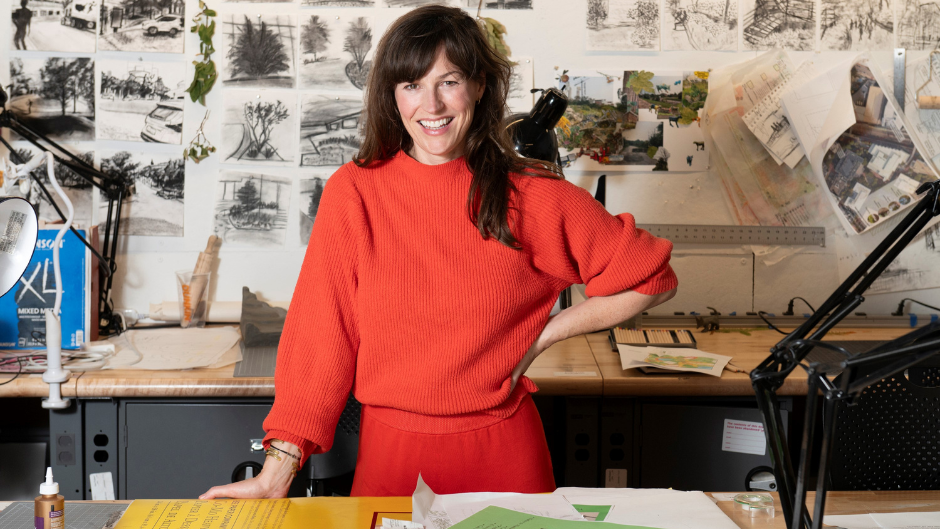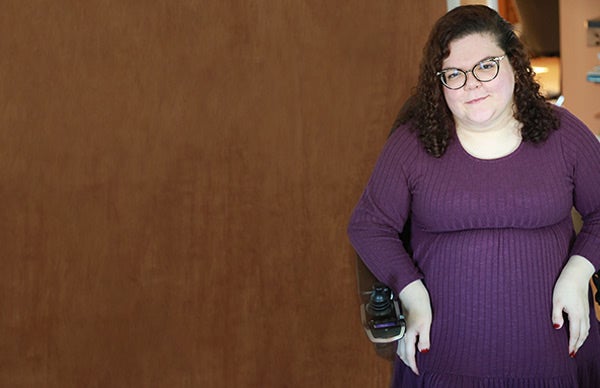Sara Hendren
Design researcher and author of What Can A Body Do?
Photo credit: Leise Jones
-
About Sara Hendren
Sara Hendren is a visionary thinker at the intersection of design, disability studies, and the built environment. From furniture to household tools to urban planning, she calls for engineering, design, and artworks that highlight the wonder and urgency of the body’s extraordinary range of needs and desires.
After nine years at Olin College of Engineering, in 2023 Hendren joined the faculty at Northeastern University’s College of Arts, Media, and Design (CAMD), where she works on an expanded research program focused on the material culture of the assisted body throughout the lifespan—from birth and death, including states of acute of dependence.
In What Can A Body Do?, Hendren takes a fascinating and provocative look at the things we use and the spaces we inhabit. From cyborg arms to customizable cardboard chairs to deaf architecture, her vivid stories make everyday design newly strange, inviting every reader to look with fresh eyes at the intersections of body and build world. What Can A Body Do? won the 2021 Science in Society Journalism Award from the National Association of Science Writers and was named a “Best Book of the Year” by NPR.
Hendren has engaged in numerous collaborative public art projects which include:
- A lectern designed for individuals of short stature
- A ramp for wheelchair dancing
- A musical navigational cane
Hendren is the co-founder of The Accessible Icon Project, an ongoing work of design activism for people with disabilities and their allies toward a more accessible world. She was Principal Investigator for “Sketch Model”, a four-year initiative to integrate arts and humanities into higher-ed STEM education, featuring artist residencies, student fellowships, and seed funding for faculty and staff to partner with Boston-area artists.
Hendren’s work has been showcased at prestigious venues such as the White House under the Obama administration, the DOX Centre for Contemporary Art, the Vitra Design Museum, and the Seoul Museum of Art. Her work is also part of the permanent collections at the Museum of Modern Art, the Victoria&Albert Museum, and the Cooper Hewitt Museum. She has been a National Fellow at the New America think tank and received support from various institutions, including an NEH Public Scholar grant, the Graham Foundation, residencies at Yaddo and the Carey Institute for Global Good, and an Artist Fellowship from the Massachusetts Cultural Council. Hendren’s writings have been featured in Harper’s, the New York Times, Wired, Art in America, and other publications.
Contact us about booking Sara Hendren for your next event.
-
Speaking Topics
Humanities in STEM: Integrating Art, Ethics, and Civic Responsibility
In this talk aimed at stakeholders in the education sector, Sara Hendren emphasizes the critical role of the humanities in STEM (Science, Technology, Engineering, and Math) education. As technology continues to transform society, how can students in science, engineering, and AI engage deeply with ethical and humanistic concerns? Beyond technical proficiency, future innovators must grapple with the "why" and "should" questions that define responsible technological development. Hendren explores how integrating philosophy, history, and the arts into STEM curricula can cultivate more thoughtful, civic-minded engineers—ensuring that the technologies we create serve human needs with wisdom and care.
What Can A Body Do? How We Meet the Built World
Prosthetics, assistive technologies, and accessible architecture all bridge the gaps between our many bodies and the built world, forming a creative legacy of flexible, generative design. But the paradox of disability under technocratic modernity presents a mixed picture of both the body and personhood. In this talk using stories and examples from all scales of design, Sara Hendren helps us to ask: What is the future of the body, assisted by its many tools and extensions? How does disability shape all our lives, and the meaning we make in dependence?
-
Video
-
Praise for Sara Hendren
Sara Hendren was truly amazing. What a fantastic mind and heart! We were expecting some well-organized lectures on the relationship between research and character; we got that and so much more. Her lecture series on “gifts, needs, and prototypes” creatively incorporated the research interests of our students as well as key points in Sara’s own life story that made these topics come alive for everybody in the room. In the post-lecture Q&A sessions, Sara demonstrated a remarkable breadth of understanding as she responded to all varieties of questions and concerns–often pulling from a wide array of intellectual/theoretical insights to weave together her answers. I would wholeheartedly recommend Sara Hendren to any of our peer institutions, and I look forward to when we have a chance to book her again.
— University of Notre DameSara was wonderful. One of the best speaker events we’ve had here. She was a gift to our whole community. Thank you for your help in making this possible!
— Christian Study Center of GainesvilleSara Hendren’s visit enlightened thoughtful discussion and discourse between design, art, and disabilities studies. Sara carried the room so well and made connections with faculty, students, staff, and members of the local community. It truly was an elevated collaborative event with Sara’s lead. Planning and logistics of having Sara here was so organized! We look forward to working with PRHSB.
— Chapman University, Design Program (Art Department)Sara’s visit/talk was a great start to our series. It created excitement—we wanted to start with a bang and received it! Working with PRHSB went smoothly and we’re grateful for our partnership.
— Calvin UniversityPraise for What Can a Body Do?
What Can a Body Do? models its subject. It has well-made sentences and an elegant structure. . . . But Hendren’s project also has a kind of deep beauty that is neither separable from design nor fully accountable to it. Some molecular-level harmony obtains when writing seems so committed to being both interesting and humane. . . . Hendren’s humanism shines…. As [she] writes, disability ‘reveals just how unfinished the world really is.’ Her gift, perhaps, is to see that as an invitation.
— The New YorkerIn prose infused with tenderness, Hendren tosses away the idea that disability is a problem to be solved and instead shows how humans’ adaptation to the built environment is a wonder to behold.
— NPRFor Hendren, disability is not a problem to be solved or a flaw to be cured: diverse bodies generate alternative understandings of the built world and should encourage us to question what we accept as ‘standard.’
— The BafflerFew books are capable of making you see the world in a fundamentally new way and this is one of them.
— National Association of Science WritersHendren illustrates a powerful idea that holds potential for the fields of urbanism, architecture, and design. . . . [the] book ripples with a sense of generative possibility around how these unique perspectives help us see the world in a different way and emancipate new ways of living together.
— Public BooksSara Hendren’s graceful, generous book invites us to create a more accessible, humane world of coexistence that thoughtfully meets bodies where they are.
— LitHubHendren shows that the purpose of accessible design should not be to fix a body, but rather to meet the body where it is. . . . Fascinating.
— BookPageHendren sees the world as it might flex and bend. . . . With intimacy, curiosity, and a bright sense of possibility, [she] investigates . . . the ways our diverse bodies interact with the world around us.
— Kirkus Reviews (starred review)The questions [Hendren] asks. . . spark a contagious curiosity. . . . It’s hard not to look up and see your surroundings in a different light.
— HumanitiesHendren makes us aware of the many ways we inhabit—and could inhabit—ourselves and the material world, including the difficult question of what ‘the good life’ really is. Nothing will look the same after reading this.
— Jenny Odell, author of How to Do NothingThis book illuminates both the daunting specificity and the inspiring universality of what most fundamentally shapes and challenges the work of design: our own bodies. Hendren forever reimagines the way we engage the built environment.
— Michael Bierut, partner, PentagramHendren’s powerful, imaginative stories open up new mental and physical worlds for all of us, allowing us to renew our relationship to time, technology, and one another.
— Anne-Marie Slaughter, author of Unfinished Business and The Chessboard and the WebSpare, elegant, and charismatic, this book is a call to carry out our ethical commitment to justice and access; it’s packed with stories and ideas that show us the way.
— Rosemarie Garland-Thomson, author of Extraordinary BodiesI love Sara Hendren’s mind. What Can A Body Do? opened my eyes to how thinking about disability can provide us all creative opportunities to make a better world for everyone.
— Austin Kleon, author of Steal Like an ArtistA poetic, pragmatic, and powerful invitation to unmake and remake the world for every body. This book is transformative!
— Ruha Benjamin, author of Race After TechnologyThoughtful and compelling. Hendren makes a very strong case for taking into account humanity in all its irregularities when remaking the world.
— Henry Petroski, author of To Engineer Is HumanIn her beautiful and brilliant What Can a Body Do, Sara Hendren helps us begin to imagine and enact a better world for human flourishing. If you are human, you need to read this book.
— Cathy N. Davidson, author of The New EducationAn urgent work, told with compassion and authority. There is room for us all in this essential book.
— Joanne McNeil, author of Lurking -
Books by Sara Hendren
-
Media About Sara Hendren
Request Fees
and Availability
- 212 572-2013
- Sara Hendren travels from Cambridge, Massachusetts
Featured Title

What Can a Body Do?
“What Can a Body Do? models its subject. It has well-made sentences and an elegant structure. . . . But Hendren’s project also has a kind of deep beauty that is neither separable from design nor fully accountable to it. Some molecular-level harmony obtains when writing seems so committed to being both interesting and humane. . . . Hendren’s humanism shines…. As [she] writes, disability ‘reveals just how unfinished the world really is.’ Her gift, perhaps, is to see that as an invitation.” —The New Yorker








